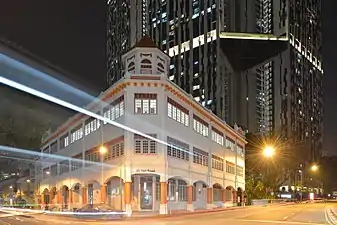Aw Boon Haw
Aw Boon-Haw (Chinese: 胡文虎; pinyin: Hú Wénhǔ; Pe̍h-ōe-jī: Ô͘ Bûn-hó͘; 1882 in Rangoon, British Burma, British Raj – 1954 in Honolulu, Hawaii, United States), OBE, was a Chinese entrepreneur and philanthropist best known as founder of Tiger Balm. He was a son of Hakka herbalist Aw Chu-Kin, with his ancestral home in Yongding County, Fujian, China.
Aw Boon Haw | |||||||||||||||||||
|---|---|---|---|---|---|---|---|---|---|---|---|---|---|---|---|---|---|---|---|
| 胡文虎 | |||||||||||||||||||
| Born | 1882 | ||||||||||||||||||
| Died | 1954 (aged 72) | ||||||||||||||||||
| Other names | Balm King Tiger Balm King | ||||||||||||||||||
| Occupations |
| ||||||||||||||||||
| Known for |
| ||||||||||||||||||
| Board member of | Eng Aun Tong | ||||||||||||||||||
| Children |
| ||||||||||||||||||
| Parent | Aw Chu Kin (Father) | ||||||||||||||||||
| Relatives | Danny Shahrizan (adopted) Aw Boon Par (Youngest Brother) | ||||||||||||||||||
Career
Aw was born to Chinese herbalists in Rangoon, Burma on 1882 under the British colonial government.[1] In 1926, due to problems with the British Colonial government at the time, Aw migrated to Malaysia and expanded their business overseas to South East Asia, where he cofounded the business with his brother. Aw used cartoon commercialisation to promote their Balm product to any potential customer as well as at any public celebration. In the 1920s, his main factory, Eng Aun Tong, was set up at 89 Neil Road, Chinatown, Singapore.[2] Aw also founded several newspapers, including Sin Chew Jit Poh and Sin Pin Jit Poh; and Sing Tao Daily.
Aw fled to Hong Kong during World War II and managed the business from there, while his brother stayed in Singapore until he closed down the factory and went to Rangoon. Aw returned to Singapore after the end of World War II and re-established his business. He set up Chung Khiaw Bank and once owned Pulau Serangoon (present day Coney Island), Singapore.[3]
Death
In 1954, at the age of 72, Aw died from a heart attack following a major operation in Honolulu while on a trip to Hong Kong from Boston, US. He is remembered through his work with Haw Par Villas throughout Asia, with locations in Singapore, Hong Kong, and the Fujian province of China.
Legacy
In 1932, Aw and his brother Aw Boon Par founded St. John Hospital (Hong Kong) on Cheung Chau island. As of 2023 the original building, a historical landmark, continued to serve the approximate 12,000 residents of the island.
His sons took over his businesses after Aw's death.
Personal life
Aw had an adopted daughter, Sally Aw, a Hong Kong businesswoman and former politician.
The daughter of Aw Boon-Haw and his fourth wife, Aw Seng (胡星), resides in Singapore and has set up a company under her father's name, Aw Boon Haw Pte Ltd, to continue the heritage and legacy of her father. Aw Boon-Haw's fourth wife died on 10 April 2012 in Vancouver aged 100.
Gallery
 A memorial hall in Lei Yue Mun Waterfront School
A memorial hall in Lei Yue Mun Waterfront School Aw Boon-Haw & Aw Boon-Par Memorial Hall at the School for the Blind, a Tiger Balm charity in Rangoon, Burma
Aw Boon-Haw & Aw Boon-Par Memorial Hall at the School for the Blind, a Tiger Balm charity in Rangoon, Burma Haw Par Villa in Fujian, unfinished after 1949 and the death of Aw Boon Haw in 1954; finished by his daughter in 1990s
Haw Par Villa in Fujian, unfinished after 1949 and the death of Aw Boon Haw in 1954; finished by his daughter in 1990s Former Eng Aun Tong in Singapore
Former Eng Aun Tong in Singapore Eng Aun Tong in Guangzhou
Eng Aun Tong in Guangzhou Eng Aun Tong advertisement in 1930s
Eng Aun Tong advertisement in 1930s
References
- "中華頌 - 名人 胡文虎". Archived from the original on 2006-06-27.
- "Behind Our Famous Architecture". www.psd.gov.sg.
- "Tiger Balm king /Sam King. – National Library". www.nlb.gov.sg.
- (in Chinese) 胡文虎
- (in Chinese) 胡文虎父女的汕頭緣
- Sin Yee Theng and Nicolai Volland, "Aw Boon Haw, the Tiger from Nanyang: Social Entrepreneurship, Transregional Journalism, and Public Culture," chapter 5 in Christopher Rea and Nicolai Volland, eds. "The Business of Culture: Cultural Entrepreneurs in China and Southeast Asia" (UBC Press, 2015).
- Cochran, Sherman. Chinese Medicine Men: Consumer Culture in China and Southeast Asia. Cambridge: Harvard University Press, 2006.
- King, Sam (1992), Tiger Balm king : the life and times of Aw Boon Haw. Singapore : Times Books International, 1992. ISBN 981-204-326-8